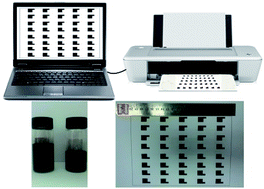Inkjet printing of conductive patterns and supercapacitors using a multi-walled carbon nanotube/Ag nanoparticle based ink†
Abstract
A multi-walled carbon nanotube (MWCNT) and silver (Ag) nanoparticle ink for inkjet printing was prepared by dispersing MWCNTs and Ag nanoparticles in water with the assistance of sodium dodecylbenzenesulfonate (SDBS). Highly conductive patterns of Ag–MWCNTs were printed on paper using a HP Deskjet 1010 inkjet printer. The patterns showed good stability during the bending test and a low sheet resistance of ∼300 Ω sq−1 after being printed 50 times. By simply adding manganese dioxide (MnO2) nanoparticles with a diameter of 60–90 nm into the ink solution, patterned positive electrodes were prepared for asymmetric supercapacitors (ASCs) with filtrated MWCNT negative electrodes. The ASCs exhibit a wide operating potential window of 1.8 V and excellent electrochemical performances, e.g. a high energy density of 1.28 mW h cm−3 at a power density of 96 mW cm−3 and a high retention ratio of ∼96.9% of its initial capacitance after 3000 cycles. The inkjet-printing acting as a simple, low-cost, non-contact deposition method can be fully integrated with the fabrication process in current printed electronic devices and has potential applications in energy storage.


 Please wait while we load your content...
Please wait while we load your content...